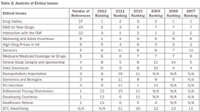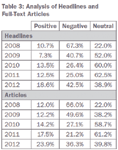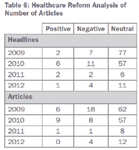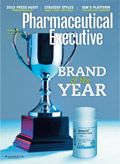Pharma in the News: Pharm Exec's Annual Press Audit
Big Pharma takes a fresh licking in our latest audit of US press coverage of business and policy issues.
Pharm Exec's ninth annual audit of media coverage of the industry marks a return to the new normal, with scrutiny finely balanced between two polarizing extremes: skepticism about drug safety against the promise of miracle cures stimulated by the billions spent on new medicines research. Negative coverage continues to be applied with a broad brush, so that the entire industry tends to be associated with the safety and quality problems of a few apostate firms, while the benefits of pharmaceutical research are often implied to be the outgrowth of a shared enterprise involving government and other stakeholders—the "you didn't build that" notion applied to Big Pharma.

(Getty Images/MB)
The annual audit, sponsored by the Arrupe Center for Business Ethics at Saint Joseph's University, tracks and analyzes industry issues covered by the media. Despite a lull in coverage through most of 2011 that kept negative exposures at bay, prior audits have found that media coverage is largely hostile toward business practices and the positions taken by pharma. This year's audit identifies the "hot button" issues attracting media attention in 2012, compares the issues and how they are covered to the trendline in previous years, and reports on the pharmaceutical companies and brands most often cited in the news. We also followed-up on our analysis of how healthcare reform has been reported by the press.
Some of the top findings for 2012 include:
» Coverage of the industry bounced back up again to 113 articles, increasing 41 percent from the previous survey, but remaining below the five-year annual average of 124 articles.
» Media coverage of the industry continues to be more critical than positive, but over the past six years, coverage is trending less negative. In 2012, 36 percent of articles were negative toward the industry compared to a six-year average of 46 percent negative articles.
» Drug safety continues to be a major focus, moving up the list of hot button issues from second to first place.
» Research and development of new drugs continues to move up the list, attracting more attention this year than ever before.
» Drug prices are receiving less media scrutiny in recent years, falling from second place in 2006 and 2007 to fifth place in 2012.
» Specific pharma companies were identified in the news (70 in 113 articles) at the highest rate since 2009, when there were 88 mentions in 123 articles; Pfizer and Roche's Genentech were the most frequently cited companies.
» Healthcare reform coverage—especially the Affordable Care Act—was up from 10 articles last year to 16 this year, and was predominantly (75 percent) neutral.
Processing the news
Once again we analyzed the top five newspapers in the United States as defined by circulation for a 12-month period and identified all front-page and editorial articles pertaining to "hot button" pharma issues. The purpose of the audit was to shed light on the following questions:
» What ethical and legal controversies face the pharma industry—and what kinds of coverage do they attract?
» Do the articles and headlines support or oppose the positions taken by the industry, as defined by the Pharmaceutical Research & Manufacturers' Association of America (PhRMA)?
» How often do reporters include the industry's perspective in stories that cover the issues of the day?
» What pharmaceutical companies and brand names are identified and discussed in the articles?
» What are the implications of these findings for the industry?
To be included in the study and in our EthicsTrak™ database, an article had to be published between October 1, 2011 and September 30, 2012 in one of the top five US newspapers (as measured by circulation)—USA Today, The Wall Street Journal, The New York Times, Los Angeles Times, and The Washington Post. It also had to focus on an ethical or legal issue facing the pharma industry and appear either as a front-page story or on the editorial page—an indication of major news and public sentiment. We focused on daily newspapers rather than the broadcast media or weekly magazines for a number of reasons. The newspapers cover a broader range of issues and in more depth than the sound bites reported on radio and TV. Business and news magazines are also constrained by their weekly or monthly formats while the newspapers have the advantage of editorial coverage that takes a specific and unambiguous position—pro or con—toward the controversies in question.
For each article, we examined four elements:
Issues. We identified and categorized the hot-button issues that were discussed in each article. Many articles covered two or more issues that were included in relevant sections.
Headlines. We analyzed the headlines and categorized them as positive, negative, or neutral toward the industry. For example, "Heart Drugs Tied to Diabetes; Statins Raise Risk of Developing Disease" (USA Today, January 10, 2012) and "Nicotine Gum And Skin Patch Face New Doubt" (TheNew York Times, January 10, 2012) were classified as negative headlines, while "Two Cheers for the Malaria Vaccine" (The New York Times, October 24, 2011) and "In a First, FDA Panel Supports Drug to Prevent HIV Infection" (The Washington Post, May 11, 2012) were labeled positive.
Tone. We also analyzed each complete article to determine whether it took a positive, negative, or neutral position toward the pharmaceutical industry. For example, any article that called for restrictions or a prohibition on DTC advertising—a position that the industry opposes—was deemed negative. In contrast, an article that claimed that DTC advertising resulted in more informed patients was designated as positive from the industry's point of view.
Balance. Regardless of the dominant position taken by the article, we also looked to see if the stories included the opposing point of view. When an explicit statement about an opposing view was included in the article—even if the two sides did not receive equal coverage—we concluded that the article covered both sides. When no mention of the opposing view was presented, the article was labeled as one-sided.

Figure 1: Number of Articles by Year
Figure 1 and Table 1 show the number of articles for 2012 compared to previous years. Results indicate that the amount of coverage the industry received is up 41 percent year-over-year, but still slightly below the six-year average of 124 articles.

Table 1: Number of Articles by Newspaper and Year
What are the hot button issues?
Table 2 identifies the issues covered in the articles, the frequency of their coverage, and how the results compare to previous years. At the top of the list of topics attracting media attention in 2012 is drug safety, an issue that has remained at or near the top of the list for many years. Another perennial focus of the media is the FDA which ranked first on the list in 2011 and dropped to third in 2012. These two issues, drug safety and the role of the FDA, continue to dominate the news and appear in articles that are typically critical of the industry and its ability to self-manage. An exception to the negative slant is TheNew York Times article (November 8, 2011) defending the FDA, reporting that of the 35 new drugs approved by the FDA during the fiscal year, 24 of those drugs were approved in the United States before gaining approval in any other country.

Table 2: Analysis of Ethical Issues
Moving up to second on the list shown in Table 2 and signaling primarily good news for the industry is research and development of new drugs. This issue continues to gain more attention over the years, steadily advancing toward the top of the list. This set of articles reported mostly good news about the industry, in the form of progress made in research and drug development. For example, TheWashington Post (January 24, 2012) reported an experimental treatment using embryonic stem cells that appeared to show progress in restoring sight. Similarly, the Los Angeles Times (February 9, 2012) reported progress on the Alzheimer's front—just as scientists are announcing a breakthrough in their understanding of how Alzheimer's spreads through the brain, robbing its sufferers of memories and cognitive functioning, the Obama Administration proposed a dramatic increase in federal funding to support the research.
Also jumping up several spots on the hot button list and attracting more scrutiny in 2012 was marketing and sales incentives. Several of the articles discussed a provision of the 2010 healthcare reform law requiring doctors, professional groups, and teaching hospitals to report virtually all payments and gifts they receive from drug and device makers for research, consulting, speaking, travel, and entertainment. The payments will be disclosed and reported in a database the public can access (USA Today, February 28, 2012; TheNew York Times, January 17, 2012).
The focus on high drug prices appears to be waning over the nine-year period of the study. In the beginning years, drug prices were consistently at or near the top of the list of hot button issues. High drug prices dropped one spot to fifth place on the list in 2012. This confirms our conclusion from last year that drug safety trumps drug prices as a focus of the media. Furthermore, two related pricing issues—importation/reimportation of drugs and differential pricing and distribution—once a significant focus of media attention, received a combined total of only four references in 2012.
Similar to last year, healthcare reform was not a heavily covered issue. Although it was an issue in the presidential debates, it did not rate spotlight prominence due to the sharp media focus on the economy. Additionally, providers were busy performing the important but less than newsworthy tasks to prepare for implementation of the Patient Protection and Affordable Care Act (PPAC) in 2014, such as installing an electronic medical record. Consistent with previous years, we separated the articles addressing healthcare into two groups. One group, which included articles that generally mention the pharmaceutical industry in relation to healthcare reform, is included in this section of the article. As shown in Table 2, there was only one such article this year. The other group, which incorporated 16 articles this year, consisted of articles about healthcare reform and will be reviewed in a separate section.
Coverage
Our nine-year analysis has found that the tone of headlines and articles tends to be more negative than positive for the industry. Last year we reported a favorable trend, however, that the proportion of both negative headlines and negative articles was declining from previous years. Table 3 shows that this trend did not continue in 2012. Negative headlines and negative articles both increased in 2012. Our headline analysis shows a jump in negative headlines from 25 percent to over 42 percent negative. At the same time, the proportion of positive headlines also increased (although more modest) while neutral headlines dropped. Headlines remain more than twice as likely to be negative (42.5 percent) than positive (18.6 percent) toward the industry. Table 3 also shows that full-text articles in 2012 were more likely to take a negative rather than positive stance toward the industry (36 percent versus 24 percent) although the article imbalance is less pronounced than that of the headlines.

Table 3: Analysis of Headlines and Full-Text Articles
Regardless of whether the article takes a primarily positive or negative tone toward the positions of the industry, our audit analyzes whether both sides of the disputed issue are at least acknowledged. This year 58.4 percent (66 of 113) of articles mentioned both sides. This is up from 41.3 percent last year.
Newspaper coverage of companies and their products
An integral part of our audit is to look at the number of times a pharma company or one of its products is mentioned. We assess which companies are attracting media attention, positive, neutral, or negative, and making the news. For example, if a company, such as Pfizer, is mentioned twice and one of its products (e.g., Bextra), is mentioned once, then that would count as three mentions for Pfizer. A higher number of mentions equates to the visibility a company is getting in a given year.
This year the 70 mentions for companies, by company name, were the highest since 2009 when there were 88. When considered by the number of articles, this year's ratio of mentions per article is substantially higher. In 2012, there were 70 mentions in 113 articles or about .6 mentions per article compared to .72 mentions per article in 2009. Additionally, this year there were more large companies (13) identified by name than any previous year. Combined with the 32 other companies mentioned, the total number of mentions was 45, the highest since 2009 when there were 88 mentions (Table 4).

Table 4: Company Mentions by Company Name
When the products from the companies mentioned by name are included, the total number of mentions increased significantly. Fifty-three products were mentioned at least once, and 13 of the products were mentioned at least twice. Perdue Pharma's Oxycontin and Genentech's Avastin had the highest number of mentions at six apiece. Both drugs continue to attract negative coverage, Oxycontin due to its street value link to addiction and Avastin due to its potential side effects, e.g. serious bleeding and gastrointestinal perforation. Pfizer has the most products mentioned. One of Pfizer's generic products, Levongestrel, had five mentions due to potential side effects associated with this birth control medication.
Newspaper coverage and healthcare reform—déjà vu?
Coverage of healthcare reform this year increased slightly over last year, from 10 to 16 articles. Although there was an increase, the number of articles is still significantly lower than the 86 and 74 articles when the PPACA was under debate in Congress before its passage in March 2010, as shown in Figure 2.

Figure 2: Number of Healthcare Articles by Year
Table 5 shows that editorials outpaced front-page articles—13 to three. Coverage decreased in two newspapers, the USA Today and The Wall Street Journal, to no coverage in 2012. However, coverage increased in the three other newspapers with the most coverage in TheNew York Times with six articles followed closely by TheWashington Post and Los Angeles Times with five articles apiece. This represented quite a rebound for the Los Angeles Times, which had no coverage in 2011.

Table 5: Healthcare Reform Articles by Newspaper
Again this year, we analyzed the top five US newspapers to address the following questions:
» Do the healthcare articles and headlines support or oppose the positions taken by the pharmaceutical industry?
» What ethical issues face the pharma industry in these articles on reform?
» How often are the industry's perspectives included in the articles?
» What pharmaceutical companies and/or brand names are identified in the articles?
» What are the implications of these findings for the industry?
The headlines as well as the articles were analyzed as positive, negative, or neutral toward the pharmaceutical industry. There was definitely a negative tone to this year's articles; only one headline was positive, with the related article being negative. Eleven of 16 headlines were neutral (68.8 percent), four were negative (25 percent), and one was positive. When full articles were considered, 12 articles were neutral, four negative, and none positive as summarized in Table 6.

Table 6: Healthcare Reform Analysis of Number of Articles
Assessing coverage by individual newspaper, The New York Times was largely neutral in its coverage with five of its six articles neutral and one negative. The Washington Post had similar coverage with four neutral articles and one negative article. Completing this year's coverage was the Los Angeles Times, which had three neutral articles and two negative ones.
When there was negative coverage, it was hard hitting as exemplified by front-page coverage in the Los Angeles Times in March, "Obama's Health Reform Law Still a Hard Sell" indicating that many important provisions are not yet phased in and that the public has seen little to inspire support. Comparisons of coverage among the five newspapers are depicted in Table 7.

Table 7: Number of Healthcare Reform Articles by Newspaper
What were the issues?
Table 8 shows that, for the third consecutive year, the top issues were related to healthcare reform and Medicare/Medicaid drug coverage. All 16 articles mentioned healthcare reform with three of those 16 articles also mentioning Medicare/Medicaid drug coverage. Issues previously mentioned, such as reimportation/importation and high drug prices, were not mentioned. The former, reimportation, appears a dead letter at this point, which may be due to the convergence of currency exchange rates between the United States and Canada.

Table 8: Ethical Issues Related to Healthcare Reform
Implications of healthcare reform for pharma
Many forecasts indicate that there will be a significant increase in the number of patients, about 35 million, obtaining healthcare insurance without the impediment of "no coverage" for pre-existing conditions. It is assumed that this will increase the demand for pharmaceuticals. Accordingly, pharma companies are taking decisive short-term and long-term actions to be prepared. This includes restructuring and in some cases adding sales reps to capture their fair share of incremental volume. Additionally, while prescribers may be less enthusiastic about the required preparatory steps before the PPACA is implemented in 2014, pharma companies are designing programs to help busy physician practioners, who may see their patient volume increase between 10 percent to 20 percent.
Long-term, pharma companies are positioning themselves for the shift in age demographics in the United States. According to the Media Policy Center, today there are more elderly parents needing care than the country's nine million children. Product solutions for medical problems attendant with age, such as Alzheimer's disease, are the next blockbuster for the pharma company that solves this challenge. Research that Lilly (a company that has remained under the media's radar screen) conducted with the Memory and Aging Program at Butler Hospital has yielded the first FDA-approved diagnostic radiopharmaceutical, Anyvid (Florbetapir F18), which uses PET scanning to estimate the beta-amyloid neuritic plaque density accompanying Alzheimer's disease. This is the type of innovative approach by pharma needed to meet the challenge.

George Sillup, PhD, is Arrupe Fellow and Associate Professor at St. Joseph's University, Philadelphia, PA. He can be reached at Sillup@sju.edu. Stephen Porth, PhD, is Associate Dean, Arrupe Fellow and Professor at St. Joseph's. He can be reached at sporth@sju.edu. Cynthia Slater, SJU's Business Reference Librarian, and SJU students Leo Porth, Danielle Puccini, and Ryan Fox also contributed to this research.
